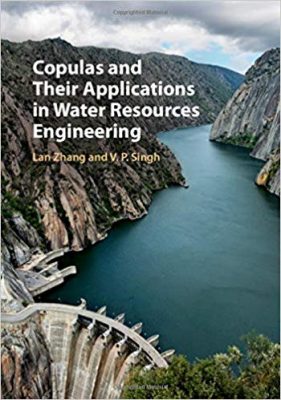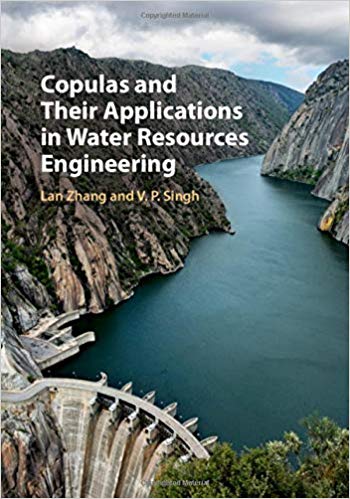 Authors: Lan Zhang and V. P. Singh
Authors: Lan Zhang and V. P. Singh
Publisher: Cambridge University Press – 603 pages
Book Review by: Sonu Chandiram
In the field of statistics, and particularly in probability theory, a copula is a multivariate cumulative distribution function for which the marginal probability distribution of each variable is uniform. In short, copulas are used to describe the dependence between random variables.
In linguistics, a copula (plural: copulas or copulae) is a word that links the subject of a sentence to a subject complement, such as the words ‘sky’ and ‘blue’ in the sentence “The sky is blue.” The word copula derives from the Latin noun for a ‘link’ or ‘tie’ that connects two different things.
In this book the authors – Ms. Lan Zhang and Dr. V.P. Singh – take the copula theory and demonstrate its applications in the science of hydrology and in water resources engineering, particularly in controlling and managing floods, drought, groundwater, hurricanes, rain storms. snowfalls and other forms of water flow and movement.
In their Introduction, Zhang and Singh write: “Complex hydrological processes…. are characterized by more than one correlated random variable. Hydrological events emanating from these processes are multivariate and their treatments require multivariate analysis.”
They point out to the works of Yue and Rasmussen who reviewed some applications of multivariate hydrological analyses using traditional frequency analysis methods with multivariate distributions
This book of around 600 pages takes a detailed look at the basis of the theory of copulas and then presents its applications in water management, particularly distribution and flow. Its content is discussed in 17 chapters organized around two Parts:
- Theory
- Introduction
- Preliminaries
- Copulas and their Properties
- Symmetric Archimedean Copulas
- Asymmetric Copulas: High Dimension
- Plackett Copula
- Non-Archimedean Copulas; Meta-Elliptical Copulas
- Entropic Copulas
- Copulas in Time-Series Analysis
- Applications
- Rainfall Frequency Analysis
- Flood Frequency Analysis
- Water Quality Analysis
- Drought Analysis
- Compound Extremes
- Network Design
- Suspended Sediment Yield Analysis
- Interbasin Transfer
Zhang and Singh point out that multivariate frequency distributions have usually been derived from one of three fundamental assumptions:
- The random variables each have the same type of marginal probability distribution
- The variables are assumed to have a joint normal distribution or are transformed to have a joint normal distribution, or
- The variable are assumed independent – a trivial case.
They explain further: “In reality, the correlated random variables Are generally dependent, do not follow the normal distribution, and/or do not have the same type of marginal distributions.”
But they caution readers that generally, multivariate hydrological analyses are mathematically complicated, and the resulting joint distributions may be valid only in a limited solution space.
But the authors in turn impart the benefit of their experience and insight to readers by stating:
“When deriving multivariate distributions, it has been demonstrated in the last two decades that the aforementioned difficulties can be overcome with the use of copulas because:
- They separate the dependence function from the marginal distributions of random variables
- The dependence function represented by the copula function is the cumulative joint distribution of correlated random variables, and
- The mutual information (bivariate / multivariate) may be expressed as a negative copula entropy that avoids the complexity of evaluating the uncertainty with the use of entropy theory (information theory).
The authors then go on to summarize copulas and their applications in the Introduction to this important book.
Authors:
Lan Zhang currently works as a postdoctoral research scholar in the Department of Agricultural and Biological Engineering at Texas A&M University. She has received her BS in mechanical engineering, her MS in water resources sciences, and her PhD in civil and environmental engineering. She has written 40+ articles in the areas of entropy, hydrology, water quality and water resources. She has been working on cupolas and their application in hydrology and water resource engineering for more than 10 years.
P. Singh is Distinguished Professor, Regents Professor and William N. Lehrer Distinguished Chair in Water Engineering at Texas A&M University Professor has published extensively in the areas of climate change, copulas, entropy, groundwater, hydraulics, hydrology, irrigation, pollutant transport, and water resources.
He had received more than 90 national and international awards, including the Arid Lands Hydraulic Engineering Award, the Environmental and Water Resources Institute (EWRI) Lifetime Achievement Award given by the American Society of Civil Engineers; the Crystal Drop Award given by the International Water Resources Association; the Hancor Soil and Water Engineering Award given by the American Society of Agricultural and Biological Engineers;
The Merriam Improved Irrigation Award given by the US Committee on Irrigation and Drainage; the Norman Medal, the Founders Award and the Rey K. Linsley Award given by the American Institute of Hydrology, the Richard R, Torrens Award, and the Ven Te Chow Award. Dr. Singh is also a recipient of three honorary doctorates and is a Distinguished Member of the of the American Society of Civil Engineers (ASCE).
He is a Fellow of the EWRI, the American Water Resources Association (AWRA), the Indian Water Resources Society (IWRS), the Indian Society of Agricultural Engineers (ISAE), the Indian Association of Soil Water Conservationists (IASWC), and the Indian Institute of Engineers (IIE). He is also a member of 10 international science and engineering academies. He has also served as president of the American Institute of Hydrology (AIH).







